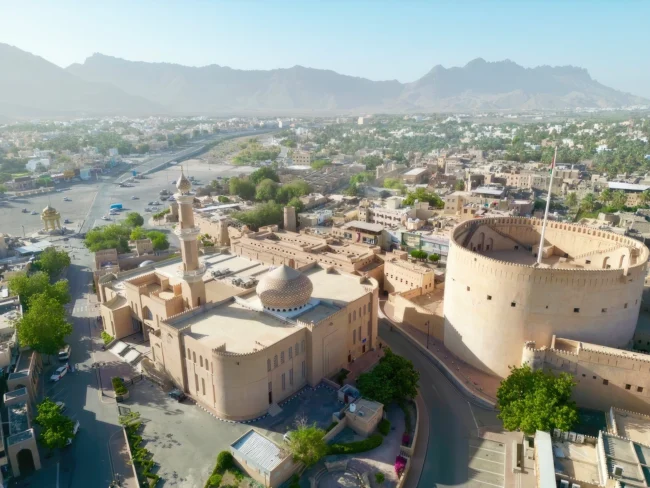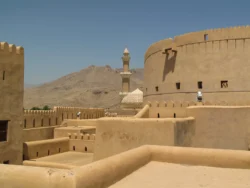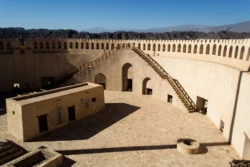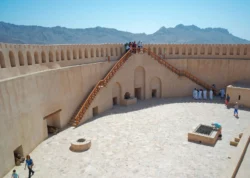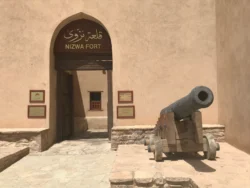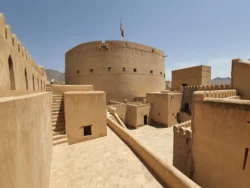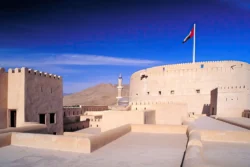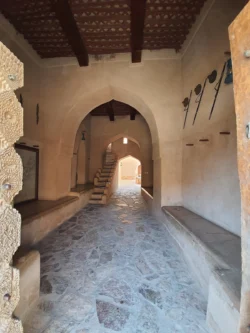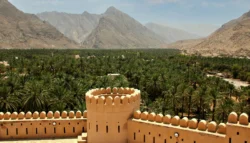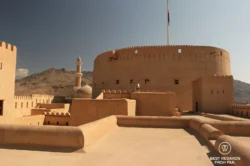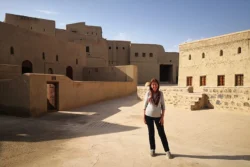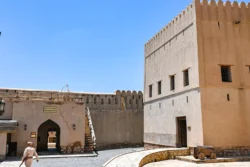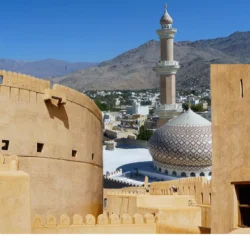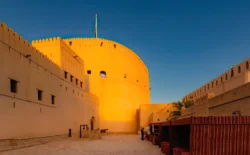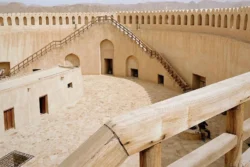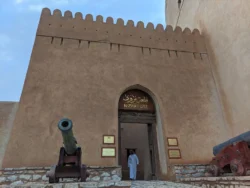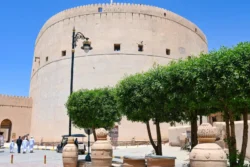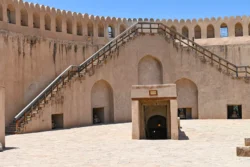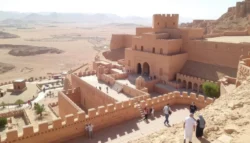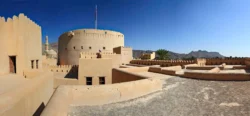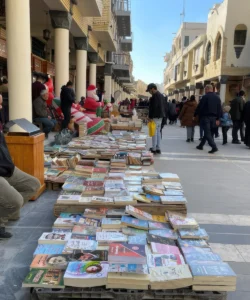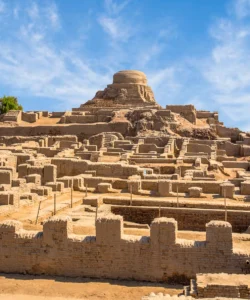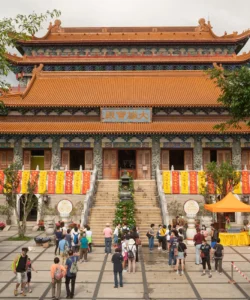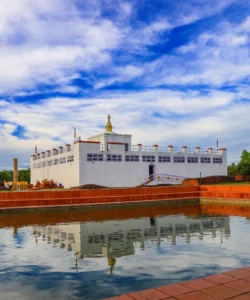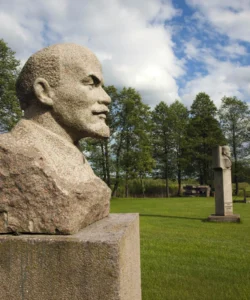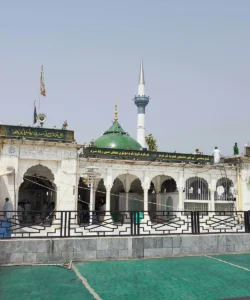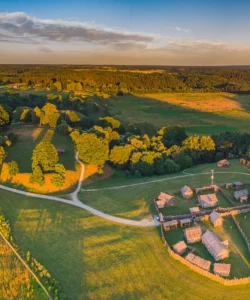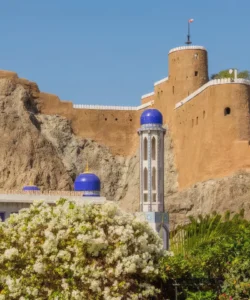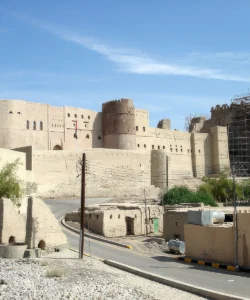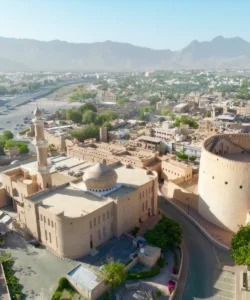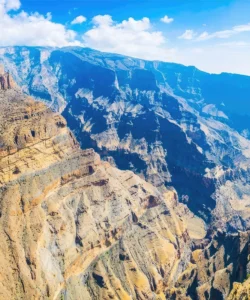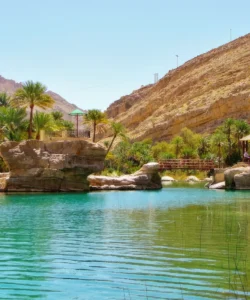Nizwa Fort, a prominent historical landmark in Oman, is a testament to the country’s rich past and architectural prowess. Built in the 17th century, it served as a crucial defensive structure and administrative seat, and today stands as one of Oman’s most visited national monuments.
Listen to an introduction about Nizwa Fort
Name and Address
- Name: Nizwa Fort (Arabic: قلعة نزوى)
- Address: Located in Nizwa, Ad Dakhiliyah Governorate, Oman. It is situated in the heart of Nizwa city, adjacent to the traditional souq.
How to Get There
Nizwa Fort is easily accessible, particularly from Muscat.
- By Car: Driving is the most popular way to reach Nizwa from Muscat. The distance is approximately 160 km (about 100 miles), taking roughly 1.5 to 2 hours via Route 15 southwest from Muscat. Parking is available near the fort.
- Public Transport: Buses operated by the Oman National Transport Company connect Muscat to Nizwa. Regular minibuses and shared taxis also travel between the cities. Once in Nizwa, the fort is easily accessible on foot from the city center.
- Organized Tours: Many tour operators offer day trips from Muscat that include Nizwa Fort, often combined with visits to other nearby attractions like Jebel Akhdar or the Nizwa Souq.
Landscape and Architecture
Nizwa Fort is an impressive example of Omani military architecture, designed for defense and administration.
- Massive Round Tower: Its most striking feature is the enormous circular tower, rising 34 to 36 meters high with a diameter of 45 meters. This central defensive structure housed 24 cannons and 480 gun ports.
- Fortification Style: The fort’s architecture is built in a strong fortification style, featuring thick mud-brick walls, intricate defense mechanisms such as trapdoors, honey traps (pits for boiling date juice), arrow slits, and secret passages.
- Complex Layout: The fort is divided into a palace section for residential and administrative purposes and a citadel for defense. Its inner architecture includes a maze of rooms, steep staircases, and “murder holes” for pouring hot liquids on invaders.
- Materials: Constructed primarily from traditional Omani materials, including mud brick and stone, which blend seamlessly with the surrounding landscape. Crushed stones formed the base, and wood was used for heavy doors and structural elements.
- Strategic Location: The fort’s strategic location overlooks the entire city of Nizwa and the surrounding mountains, providing panoramic views from the top of the tower.
What Makes It Famous
Nizwa Fort is famous for several key reasons:
- Historical Significance: It played a pivotal role in Oman’s history, particularly in expelling the Portuguese and serving as the administrative seat for imams and walis during both peaceful and turbulent times. It is Oman’s most visited national monument.
- Architectural Marvel: Its unique circular design, massive tower, and elaborate defensive features make it a remarkable example of 17th-century Omani military architecture.
- Cultural Insight: The fort houses a museum with 20 galleries showcasing traditional crafts, weaponry, and various aspects of Nizwa’s history and culture. Demonstrations of ancient techniques like pottery making and basket weaving are also held.
- Unaltered Stronghold: It is renowned for never having been captured, a testament to its formidable defenses.
- Panoramic Views: Climbing to the top of the tower offers breathtaking panoramic views of Nizwa city and the surrounding Hajar Mountains.
- Adjacency to Nizwa Souq: Its proximity to the bustling Nizwa Souq, one of Oman’s oldest marketplaces, enhances the visitor experience, offering a glimpse into traditional Omani commerce and daily life.
Differences from Some Other Attractions
Nizwa Fort distinguishes itself from other attractions in several ways:
- Purpose-Built Fortification: Unlike natural wonders (like Wahiba Sands) or purely residential castles, Nizwa Fort is primarily a purpose-built military stronghold, showcasing advanced defensive engineering of its time.
- Urban Integration: While many forts in Oman are more isolated, Nizwa Fort is seamlessly integrated into the urban fabric of Nizwa city, blending with the adjacent mosque and souq, offering a unique urban historical experience.
- Defensive Ingenuity: It stands out for its elaborate and deceptive defensive mechanisms, such as pitfalls, honey traps, and numerous gun ports, which are a central part of its historical narrative and visitor experience.
- Historical Narrative Focus: The fort’s fame is deeply intertwined with its direct role in significant historical events, particularly the expulsion of the Portuguese, making it a symbol of Omani resistance and independence.
- Museum and Educational Value: The extensive museum and interactive exhibits within the fort provide a comprehensive educational experience about Omani history, culture, and traditional life, which might be less emphasized in other sites.
Nizwa Fort Photos:
